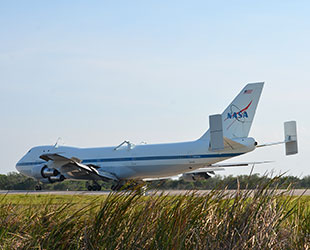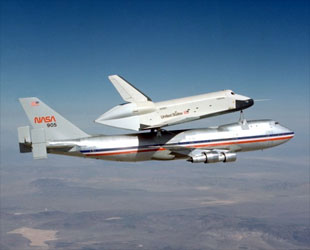April 10, 2012 — Space shuttle Discovery's chartered ride to retirement has arrived.
The modified Boeing 747, referred to as the Shuttle Carrier Aircraft (SCA), touched down at NASA's Kennedy Space Center in Florida on Tuesday (April 10). The jumbo jetliner came in from Dryden Flight Research Center in California to ferry Discovery to the Smithsonian, where the shuttle is set to go on public display.
The aircraft landed at 5:35 p.m. EDT (2135 GMT) on the same runway that Discovery used to return from space for a 39th and final time on March 9, 2011.
In the year since, technicians have prepared Discovery for its exhibit at the National Air and Space Museum's Steven F. Udvar-Hazy Center in Virginia. The orbiter's hazardous materials were removed and some components, such as its three main engines, were replaced with replicas so they could be kept for possible future reuse.

The Shuttle Carrier Aircraft rolls out on the same runway where its soon to be passenger, shuttle Discovery, landed from space. |
On Saturday (April 14), shuttle technicians will use a steel gantry-like structure known as the Mate-Demate Device, to hoist Discovery and secure it atop the SCA. Weather permitting, the paired air- and space-craft will take off for Washington Dulles International Airport on the morning of April 17.
Look up! It's a bird and a plane...
The SCA will take to the air on what will be its 806th flight in service to NASA — 218 with a shuttle on its back, and 38th with Discovery — and fly south. Weather permitting, spectators at the Kennedy Space Center Visitor Complex and along Cocoa Beach will get a clear view of the orbiter before the flight continues on up the Eastern Seaboard.

A NASA T-38 training jet is seen as it flies over Washington, DC, following a possible route for the Shuttle Carrier Aircraft with the space shuttle Discovery. (NASA / Robert Markowitz) |
The exact flight plan is weather contingent, but once over the nation's capital, the SCA will fly Discovery about 1,500 feet above various parts of Washington.
"The aircraft is expected to fly near a variety of landmarks in the metropolitan area," NASA said on April 9, "including the National Mall, Reagan National Airport, National Harbor and the Smithsonian Udvar-Hazy Center. When the flyover is complete, the SCA [with Discovery] will land at Dulles International Airport."
According to the Smithsonian, the 747-Discovery combo is expected to make a low fly-by of the airport at 10 a.m. EDT (1400 GMT), and will touch down about 40 minutes later. The SCA is expected to roll to a stop on the tarmac just before 11 a.m. EDT (1500 GMT).
In addition to spotting the shuttle as it flies overhead, the museum has invited the public to view the final approach from the parking lot of the Udvar-Hazy Center. Then two days later on April 19, the public is invited to return for an arrival ceremony, which will kick off a four-day "Welcome Discovery" festival.
Shared ride
The SCA will not be returning to Florida after dropping off Discovery.
Instead, another shuttle, the prototype Enterprise, will be loaded atop of the 747 at Dulles Airport for its own flight to New York the following week. While Enterprise never flew in space, it was the first to fly on a Shuttle Carrier Aircraft for a series of approach and landing tests in the 1970s.

Space shuttle Enterprise flying atop the carrier aircraft, a Boeing 747, during its first captive test flight in 1977. (NASA) |
Since 2003, Enterprise has been on public display at the Udvar-Hazy Center. It is being moved to the Intrepid Sea, Air and Space Museum, a converted aircraft carrier that is berthed in Manhattan, to make room for Discovery.
Weather permitting, the SCA will take off with Enterprise on April 23, flying to John F. Kennedy (JFK) International Airport. NASA and the Intrepid have yet to release details about sighting opportunities or planned flybys.
After delivering Enterprise, the SCA will return to Florida to wait for its final mission: flying space shuttle Endeavour to Los Angeles this September.
Visit shuttles.collectspace.com for continuing coverage of the delivery and display of NASA's retired space shuttles.
